Samsung Galaxy Note 7 Review
Samsung Galaxy Note 7
UPDATE: Samsung recalls Note 7
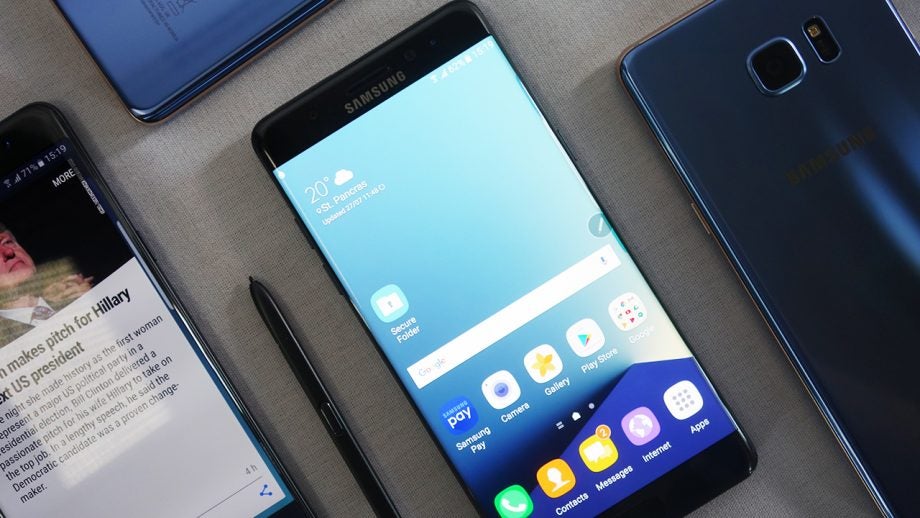
Sections
- Page 1 Samsung Galaxy Note 7 Review
- Page 2 Performance, S Pen and Software Review
- Page 3 Camera Review
- Page 4 Battery life and verdict Review
Verdict
Key Specifications
- Review Price: £749.00
- 5.7-inch quad-HD Super AMOLED display
- Octa-core CPU
- 4GB RAM
- 64GB storage + microSD slot
- S Pen stylus
- Android 6.0.1
- Fingerprint and Iris scanner
- USB-C
- Fast and wireless charging
- 3,500mAh battery
- IP68 water resistance
- 153.5 x 73.9 x 7.9mm, 169g
- 12MP camera, f1.7 aperture
What is the Samsung Galaxy Note 7?
Things ended badly for the Samsung Galaxy Note 7. After a number of incidents, the phone was eventually recalled and never went on sale again in its original state. Since then Samsung has released the Note 8 and is about to launch the Galaxy Note 9.
Related: Samsung Galaxy Note 9
We’ve removed the score from our original review, but you can get still read our original thoughts below if you’re so inclined.
Samsung Galaxy Note 7 – Design and Build
While the Samsung Galaxy Note 7 might look like a minor tweaking of the design formula started with the Galaxy Note 5 and improved with the Galaxy S7 earlier in 2016, it’s actually a big signal of intent.
For the first time, Samsung has released a phone with only the option of a dual-curved-edge screen. This isn’t like the Galaxy S6 and S6 Edge, nor the Note 5 and Galaxy S6 Edge Plus. Samsung is giving you one curvaceous option and saying that the curved-edge ‘experiment’ is now complete. This is the path the Korean company wants to take.
Related: Best Android phones
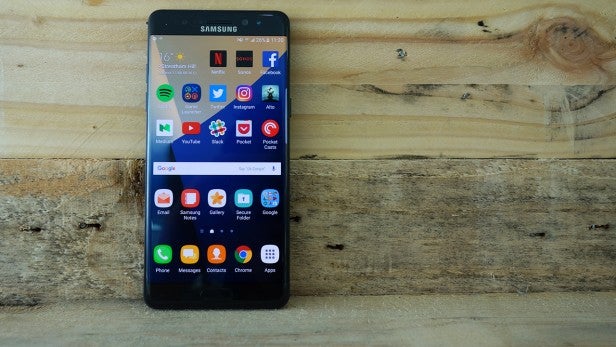
I wouldn’t be surprised if next year’s Samsung Galaxy S8 takes a similar approach and ditches the flat version, going curvy all the way.
The Galaxy Note 7 is the pinnacle of Samsung’s design and is the culmination of everything the company’s learned since ditching faux-leather and plastic disguised as metal.
The curved display is the headline trait, but even that’s come a long way since it was first used on the ill-fated Galaxy Note Edge. It’s even been improved over the one on the Galaxy S7 Edge, as the curve is less obvious and, well, less curvy. It juts down at a steeper angle and takes less screen real estate away, but it’s just as eye-catching as ever.
Following the curve on the front is a similar roundedness to the back, which was a small design alteration introduced on the Galaxy Note 5. The biggest achievement here is just how comfortable the phone feels, considering it has a 5.7-inch screen. It’s smaller in every dimension than both the iPhone 6S Plus and Huawei Nexus 6P, making it easier to hold and use than both of those phones.
This is huge, because finally you get all the benefits of the big screen without worrying about juggling it in your hands.
The Note series has always been marketed as more of a ‘business’ device, and while this is just marketing speak that isn’t really relevant, it feeds into the design. The Note 7 is more straight and boxy than the rounded Galaxy S7 brothers, which are a little more fun to look at.
Related: Best phablets to buy right now
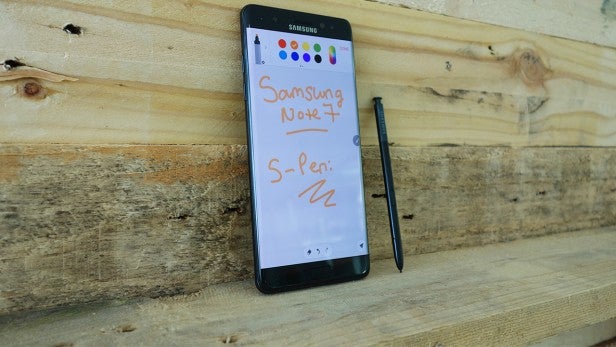
It’s still completely formed from metal and glass, and stands out as being the best-looking phone you can buy right now. It’s more ergonomic than the HTC 10, less boring than the iPhone 6S and not as sharp as the Nexus 6P. It’s also water-resistant enough to be dunked in the bath for about 30 minutes.
Another ‘first’ for the Samsung Galaxy Note 7 is Gorilla Glass 5. This glass not only covers the front, but the back too, and it should protect the phone if you happen to drop it – which no doubt you will at some point. I’ve been vocal in the past about how my biggest annoyance with these flagship phones is their delicate nature.
Buy Now: Galaxy Note 7 at Amazon.com from $903
I’ve dropped my Galaxy S7 Edge from about 2ft onto a wooden floor and it caused a snaking crack down the back, while a colleague dropped one from a similar height onto concrete and destroyed the whole front.
Thankfully, and I’m sure the Samsung PR folk will be happy to hear this, I haven’t dropped the Note 7. Yet. So I can’t really say if Gorilla Glass 5 is a whole heap better than 4, but I’ll definitely update this review once I’ve used it for a few months (and probably dropped it).
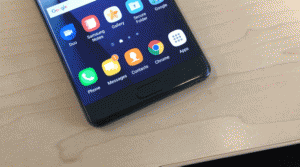
Samsung Galaxy Note 7 – Display
Its size was once the story with the Note series. Its size set it apart. It was huge, unmanageable, basically a tablet. How big was the display on the original Note? It was 5.3 inches. That’s now considered small.
And while the Note’s display has grown to 5.7 inches, it’s no longer the differentiator. Other phones, such as the Nexus 6P, are the same size, and while the iPhone 6S Plus has a smaller display, it has a bigger footprint.
But even though it may not stand out for its size, the Note 7 does so because of its quality – something arguably much more important.
Like all of Samsung’s flagships, and even some of its cheaper phones like the Galaxy J3, the starting point is the Super AMOLED panel. It might not have the viewing angles you get with an IPS LCD, but the oomph and joyous colours more than make up for that. Samsung’s honed this display technology over time and it’s now the best it’s ever been.
(uswitch type=table brand=Samsung model=Galaxy_Note_7 limit=1)
Colours are strong and vibrant, blacks are dark and there’s no muddiness in the whites. It’s a joy to look at, and its brightness means it’s perfectly viewable even in direct sunlight. This is the brightest phone screen I’ve ever used, and it’s mightily impressive. There are some minor reflections if you look very closely near the edge of the display, but it doesn’t affect use.
Related: Note 7 vs Nexus 6P

Instead of upping the resolution to 4K – something that was heavily rumoured – Samsung has kept it at quad-HD. With a pixel density of 518ppi, individual pixels are impossible to spot, even if you get really close.
While it hasn’t added 4K, it has added HDR (high dynamic range). Well, Samsung calls it ‘Mobile HDR’, but it works in a similar way to how it functions on an HDR-compatible television. It’s a display tech that improves contrast while retaining extra detail in the brightest and darkest areas of the picture. Many in the TrustedReviews office will tell you that HDR is more important than 4K. It’s a big deal.
Most HDR content comes from a service, such as Amazon Video or Netflix, piped through a dedicated box or supported television. The new Xbox One S, for example, can play both HDR content and games if you’ve got the right television to display them
It works a bit differently on the Note 7, though. Along with streaming actual HDR content, there’s a mode that bursts into life when a supported app is opened. Start up Netflix, YouTube, Amazon Prime or the dedicated video app and a ‘Video enhancer mode’ will kick in. This simulates the idea of HDR, boosting the brightness and fiddling about with the contrast settings.
It does make a very visible difference, but at times It can be a little jarring. The move from a typical phone screen to one that feels like it’s trying to sear your retinas is odd, but the results are great.
I do feel this would work better on a tablet, as that’s meant to be used for media, whereas I rarely sit back and watch anything other than YouTube on my phone. Still, it’s typical of the Note series to deliver something we haven’t seen before, perhaps as some sort of trial. I wouldn’t be surprised if we see this tech trickle down to the Galaxy S8, and hopefully the Samsung Galaxy TabPro S2.
Related: What is HDR?
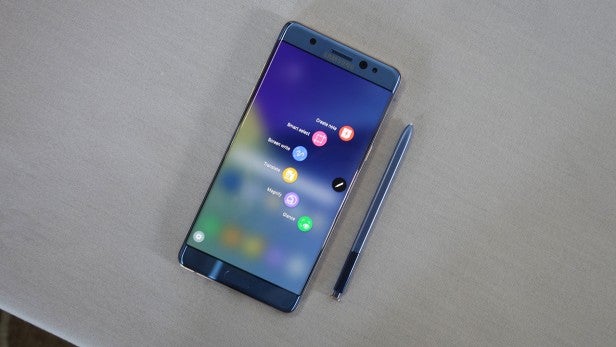
Just like the Galaxy S7, the Note 7 has an ‘Always-on display’. Even when the phone is locked, a clock and a row of notification icons glow on the screen. The bonus with AMOLED tech is that it only needs to light up individual pixels, so there’s not a huge drain on battery from this feature. My biggest issue with the original way the AOD worked has been resolved, as it’ll now display icons from every app rather than just Samsung’s own.
It’s a nice, if unessential, feature that can be both annoying and useful. But at least you can turn it off.
How we test phones
We test every mobile phone we review thoroughly. We use industry standard tests to compare features properly and we use the phone as our main device over the review period. We’ll always tell you what we find and we never, ever, accept money to review a product.


